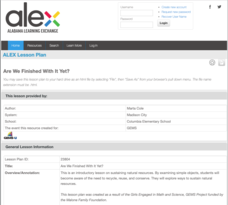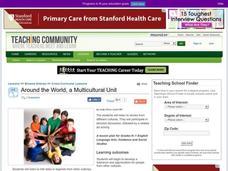Curated OER
How Does the Air Get Polluted?
Students listen to or read a story that introduces awareness of environmental issues and in particular pollution.
Curated OER
EEEK! A Spider!
Youngsters complete a unit of lessons based on the story "Little Miss Muffet." They predict what will happen in the story, and use context clues to look for meaning in the words. They research information about spiders using the Internet...
Curated OER
The Very Hungry Caterpillar
Here is a good activity on butterflies and caterpillars. After listening to The Very Hungry Caterpillar, young learners put cards that depict the life cycle of a butterfly in the correct order. There are some good ideas for center...
Indian Land Tenure Foundation
Sharing Resources: The Nuts Game
The land has always provided its inhabitants with resources that allow them to survive. However, sometimes resources run scarce and sharing becomes an important task. Help little ones understand why and how people have shared resources...
Curated OER
Affecting Transportation Choices-Walk, Don't Ride!
Students discuss methods of transportation they use and create a trip tally to determine which methods they use the most.
Curated OER
Conversation Heart Bingo
Primary learners play conversation heart bingo in order to write common phrases. They will create a bingo card with common phrases from conversation heart candy. The teacher calls out phrases and the learners cover them with conversation...
Alabama Learning Exchange
Heads, Shoulders, Knees, and Toes
The identification of various parts of the human body is the focus of this biology lesson. Young scientists sing the song "Head, Shoulders, Knees, and Toes," and trace the human body onto butcher paper. Additionally, they label the parts...
Curated OER
Whodunnit?
Want to create an exciting mystery activity? Investigators will identify the elements of a mystery, review mystery stories, then write their own mysteries. They engage in forensic science experiments related to mysteries and learn to ask...
Curated OER
Working in Photographs
Students analyze illustrations of workers in the 19th and 20th centuries. In this social science instructional activity, students examine photographs of workers and identify the types of work that were available in the 19th century...
Curated OER
Estimating
Students complete a worksheet. In this estimation lesson, students view various ties and estimate the number of objects or pictures on it. Students complete a worksheet on estimation and then make their own tie pattern.
Alabama Learning Exchange
Making and Observing Life in a Terrarium
Young scholars understand the parts of the terrarium and why they are important in establishing an ecosystem. In this ecosystem lesson, students recall background information on aquariums, terrariums and the water cycle. Young scholars...
Alabama Learning Exchange
Are We Finished with It Yet?
Learners recognize the importance of natural resources and that we need to conserve, reuse and recycle them. In this conserving natural resources lesson, students are given one object and must create something with it. Young scholars...
Curated OER
We Care About Fire Safety
Students investigate the hazards of fires and how to best protect themselves and their family. In this home safety instructional activity, students examine the importance of a smoke detector and discover how many homes are missing...
Curated OER
Transportation and Mapping
Young scholars view murals that depict various modes of transportation. They discuss the importance of maps to navigation and create a map. They compare and contrast transportation of the past with modes of transportation used today.
Curated OER
Alphabetize For A Reason
Students organize information by using the alphabet. Students organize materials alphabetically. Students alphabetize with the first, second and third letters of a set of words. Students discover applications for alphabetical order.
Curated OER
An Encyclo-ME-dia for Every Child
Learners create a digital scrapbook that shows information-text and pictures that are specific to each child. They make charts and graphs. They use digital cameras, scanners, software, to write captions, stories, poems, letters, and...
Curated OER
Naughty or Nice?
Pupils practice computer skills by generating Christmas lists and communicating with Santa using the Internet.
Curated OER
Heart Healthy Food Musical Chairs
Students participate in a game of musical chairs that discusses heart health. In this health lesson, students walk around a group of chairs and when the music stops they sit down. Some chairs will have index cards with a picture of a...
Curated OER
Around the World, A Multicultural Unit
Students investigate Native American tribes through their stories. In this cultural lesson plan, students read stories of the Inuit tribe and discuss the themes, people, and customs. Students illustrate a picture of the Inuit...
Curated OER
Flawed Democracies, Human Rights
Students create drawing that tell a story about a young girl's life in an internment camp. In this internment camp lesson plan, students hear stories and analyze photographs of internment camps and then create their own drawings.
Curated OER
Stories Of Seasons
Students listen to the story "Henry and Mudge Under The Yellow Moon," and write their own story based on a season. In this writing lesson plan, kindergarteners are assisted in "writing" their story by an older student or the teacher....
Curated OER
Every Day Is Presidents' Day at the White House
Students explore the history of the White House and the role of the president. They explore the White House Historical Association website, answer questions, create a drawing of the Oval Office, and take an online quiz.
Curated OER
Pet Detective WebQuest
Students take an online tour to learn about pets and their care. They click on selected Web links and answer questions about the material they encounter. They share something they learned from the WebQuest with a partner.
Curated OER
Property: Ownership, Respect, and Responsibility
Students learn to respect others' property by rating the severity of a variety of damaging acts. Students use a tag board "thermometer" to rate the severity of statements describing situations where a person damages the property of another.






















